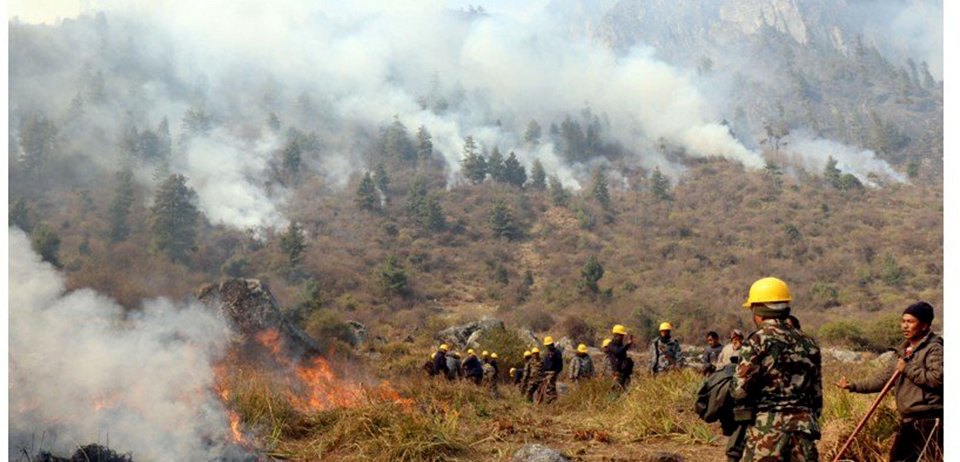With 336 incidents of forest fire, this January recorded greatest number of wildfires in a decade in Nepal

By Pramod Kumar Tandan, Kathmandu, Feb. 2: Though the peak season for wildfire is yet to begin, Nepal has already witnessed 336 incidents of wildfires in a month alone, in January this year.
March and April months are taken as the peak season for forest fires in Nepal.
Only 17 incidents of forest fires were recorded in January 2020 while the number of forest fires in the same month in 2019 was 56, in 2018 the number was 76, 29 incidents in 2017, 37 incidents in 2016, 8 wildfires in 2015, 21 in 2014, 45 in 2013 and no wildfire was recorded in the same month-January- in 2012.
The whooping increase in the number of forest fires in January this year compared to the same month previous year may indicate a severe effect of climate change and fuel load in the forest.
According to the Forest Fire Detection and Monitoring System of the Ministry of Forest and Environment, 43 districts out of 77 have already witnessed wildfire within the month.
Of them, Manang district has the highest record of forest fires with 42 incidents while Gorkha district recorded 38 incidents, Lamjung 30, Jajarkot 25, Myagdi 22, Bajhang 19, Dolpa 15, and West Rukum recorded 12 incidents of wildfire.
Similarly, 11 wildfires in Bajura, 8 each in Bardiya and Dhading, 7 each in Dailekh, Kalikot, Kaski and Rasuwa, 6 each in Achham, Darchula, Humla and Taplejung, 5 each in Makawanpur and East Rukum, 4 each in Baglung, Baitadi, Doti and Mugu and 3 wildfires recorded in Arghakhanchi.
Likewise, two wildfires were detected each in Bara, Jumla, Kailali, Kanchanpur, Nuwakot, Palpa, Shindhupalchowk and Solukhumbu, and one was detected each in Dadeldhura, Khotang, Panchthar, Pyuthan, Rautahat, Sankhuwasabha, Sindhuli, Surkhet and Tanahun.
Fire Focal Person of the Department of Forest and Soil Conservation and the Coordinator of Regional South Asia Wildland Fire Network Sundar Sharma said that piled fuel loads in various jungles have contributed to spread the forest fire prior to peak season.
Fuel load includes forest litters lying on the ground, grass, small shrubs, trees, logs, stumps, barks among others.
"There were few incidents of forest fire last year so that remaining fuel loads piled up with the fresh fuel loads across the forest areas of Nepal." Sharma told TRN Online, "As a result adequate fuel load and very little rainfall as well as a snowfall of this winter, the country witnessed more than 300 incidents of forest fires prior to the peak season."
According to Sharma almost all forest fires in Nepal are human-induced. Intentional causes such as burning for stimulation of new grass and negligence such as smokes alone share about 45 percent of fires among all known causes' forest fires.
"In Nepal, about 64 percent of fires are set by people intentionally, 32 percent due to accidental or carelessness, and 4 percent fires caused by unknown causes," added fire focal person Sharma.
According to the Department of Forest and Soil Conservation, 1,528,829 hectors of forest area were burnt due to forest fire between 2005 to 2020. The forest area of Nepal is estimated to be 5.5 million hectors that cover 37.4 percent of the total area of the country.
As per section 49 of Forest Act 2076, setting fire or do anything that may cause a fire accident in the national forest is prohibited. Similarly, Section 50 of the Act mentions that any person who commits such offence shall be punished after calculating the loss caused by imprisonment for a term not exceeding three years or a fine of not more than Rs 60 thousand or both.
Fire spokesperson Sharma said that the provisions for fire prevention are still ineffective because of the human behavior and procedural difficulty to identify the offender.
Recent News

Do not make expressions casting dout on election: EC
14 Apr, 2022
CM Bhatta says may New Year 2079 BS inspire positive thinking
14 Apr, 2022
Three new cases, 44 recoveries in 24 hours
14 Apr, 2022
689 climbers of 84 teams so far acquire permits for climbing various peaks this spring season
14 Apr, 2022
How the rising cost of living crisis is impacting Nepal
14 Apr, 2022
US military confirms an interstellar meteor collided with Earth
14 Apr, 2022
Valneva Covid vaccine approved for use in UK
14 Apr, 2022
Chair Prachanda highlights need of unity among Maoist, Communist forces
14 Apr, 2022
Ranbir Kapoor and Alia Bhatt: Bollywood toasts star couple on wedding
14 Apr, 2022
President Bhandari confers decorations (Photo Feature)
14 Apr, 2022










